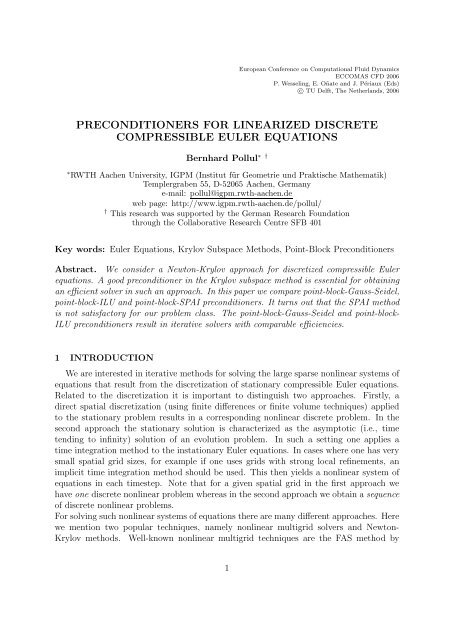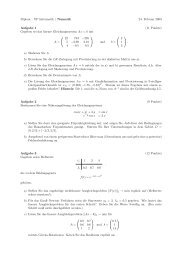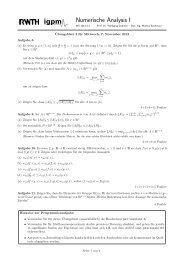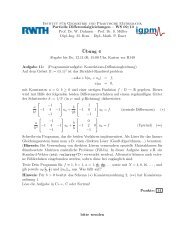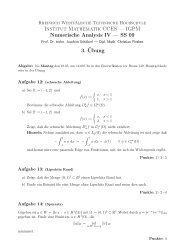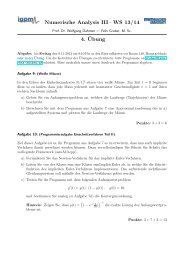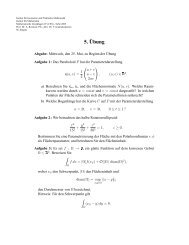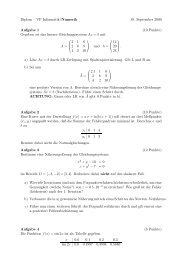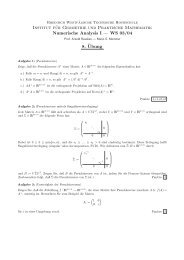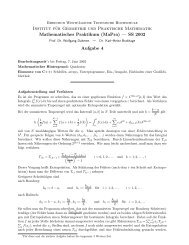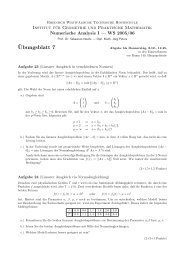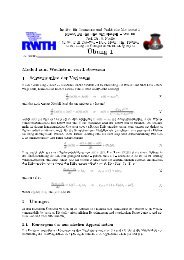preconditioners for linearized discrete compressible euler equations
preconditioners for linearized discrete compressible euler equations
preconditioners for linearized discrete compressible euler equations
Create successful ePaper yourself
Turn your PDF publications into a flip-book with our unique Google optimized e-Paper software.
European Conference on Computational Fluid Dynamics<br />
ECCOMAS CFD 2006<br />
P. Wesseling, E. Oñate and J. Périaux (Eds)<br />
c○ TU Delft, The Netherlands, 2006<br />
PRECONDITIONERS FOR LINEARIZED DISCRETE<br />
COMPRESSIBLE EULER EQUATIONS<br />
Bernhard Pollul ∗ †<br />
∗ RWTH Aachen University, IGPM (Institut für Geometrie und Praktische Mathematik)<br />
Templergraben 55, D-52065 Aachen, Germany<br />
e-mail: pollul@igpm.rwth-aachen.de<br />
web page: http://www.igpm.rwth-aachen.de/pollul/<br />
† This research was supported by the German Research Foundation<br />
through the Collaborative Research Centre SFB 401<br />
Key words: Euler Equations, Krylov Subspace Methods, Point-Block Preconditioners<br />
Abstract. We consider a Newton-Krylov approach <strong>for</strong> discretized <strong>compressible</strong> Euler<br />
<strong>equations</strong>. A good preconditioner in the Krylov subspace method is essential <strong>for</strong> obtaining<br />
an efficient solver in such an approach. In this paper we compare point-block-Gauss-Seidel,<br />
point-block-ILU and point-block-SPAI <strong>preconditioners</strong>. It turns out that the SPAI method<br />
is not satisfactory <strong>for</strong> our problem class. The point-block-Gauss-Seidel and point-block-<br />
ILU <strong>preconditioners</strong> result in iterative solvers with comparable efficiencies.<br />
1 INTRODUCTION<br />
We are interested in iterative methods <strong>for</strong> solving the large sparse nonlinear systems of<br />
<strong>equations</strong> that result from the discretization of stationary <strong>compressible</strong> Euler <strong>equations</strong>.<br />
Related to the discretization it is important to distinguish two approaches. Firstly, a<br />
direct spatial discretization (using finite differences or finite volume techniques) applied<br />
to the stationary problem results in a corresponding nonlinear <strong>discrete</strong> problem. In the<br />
second approach the stationary solution is characterized as the asymptotic (i.e., time<br />
tending to infinity) solution of an evolution problem. In such a setting one applies a<br />
time integration method to the instationary Euler <strong>equations</strong>. In cases where one has very<br />
small spatial grid sizes, <strong>for</strong> example if one uses grids with strong local refinements, an<br />
implicit time integration method should be used. This then yields a nonlinear system of<br />
<strong>equations</strong> in each timestep. Note that <strong>for</strong> a given spatial grid in the first approach we<br />
have one <strong>discrete</strong> nonlinear problem whereas in the second approach we obtain a sequence<br />
of <strong>discrete</strong> nonlinear problems.<br />
For solving such nonlinear systems of <strong>equations</strong> there are many different approaches. Here<br />
we mention two popular techniques, namely nonlinear multigrid solvers and Newton-<br />
Krylov methods. Well-known nonlinear multigrid techniques are the FAS method by<br />
1
Bernhard Pollul<br />
Brandt [11], the nonlinear multigrid method by Hackbusch [16] and the algorithm introduced<br />
by Jameson [20]. It has been shown that a nonlinear multigrid approach can result<br />
in very efficient solvers, which can even have optimal complexity ([21, 25, 26, 28]). For<br />
these methods, however, a coarse-to-fine grid hierarchy must be available. The Newton-<br />
Krylov algorithms do not require this. In these methods one applies a linearization technique<br />
combined with a preconditioned Krylov subspace algorithm <strong>for</strong> solving the resulting<br />
linear problems. One then only needs the system matrix and hence these methods are in<br />
general much easier to implement than multigrid solvers. Moreover, one can use efficient<br />
implementations of templates that are available in sparse matrix libraries. Due to these<br />
attractive properties the Newton-Krylov technique is also often used in practice (cf., <strong>for</strong><br />
example, [27, 29, 30, 31, 32, 42]).<br />
In this paper we consider the Newton-Krylov approach. A method of this class has been<br />
implemented in the QUADFLOW package, which is an adaptive multiscale finite volume<br />
solver <strong>for</strong> stationary and instationary <strong>compressible</strong> flow computations. A description<br />
of this solver is given in [4, 8, 9, 10, 37]. For the linearization we use a standard (approximate)<br />
Newton method. The resulting linear systems are solved by a preconditioned<br />
BiCGSTAB method. The main topic of this paper is a systematic comparative study<br />
of different basic preconditioning techniques. The <strong>preconditioners</strong> that we consider are<br />
based on the so-called point-block approach in which all physical unknowns corresponding<br />
to a grid point or a cell are treated as a block unknown. As <strong>preconditioners</strong> we use the<br />
point-block-Gauss-Seidel (PBGS), point-block-ILU (PBILU(0)) and point-block sparse<br />
approximate inverse (PBSPAI(0)) methods. The main motivation <strong>for</strong> considering the<br />
PBSPAI(0) preconditioner is that opposite to the other two <strong>preconditioners</strong> this method<br />
allows a trivial parallelization. We do not know of any literature in which <strong>for</strong> <strong>compressible</strong><br />
flows the SPAI technique is compared with the more classical ILU and Gauss-Seidel<br />
<strong>preconditioners</strong>. In our comparative study we consider three test problems. The first<br />
one is a stationary Euler problem on the unit square with boundary conditions such that<br />
the problem has a trivial constant solution. For the second test problem we change the<br />
boundary conditions such that the problem has a solution consisting of three different<br />
states separated by shocks, that reflect at the upper boundary. In these first two test<br />
problems we use the Van Leer flux vector-splitting scheme [24] <strong>for</strong> discretization. We do<br />
not use an (artificial) time integration method. The third test problem is the stationary<br />
Euler flow around an NACA0012 airfoil. This standard case is also used <strong>for</strong> testing the<br />
QUADFLOW solver in [10]. Discretization is based on the flux-vector splitting method of<br />
Hänel and Schwane [18] combined with a linear reconstruction technique. For determining<br />
the stationary solution a variant of the backward Euler scheme (the b2-scheme by Batten<br />
et. al. [6]) is used. For these three test problems we per<strong>for</strong>m numerical experiments <strong>for</strong><br />
different flow conditions and varying mesh sizes.<br />
While the PBSPAI(0) preconditioner turns out to unsuitable, the efficiencies of the<br />
PBGS preconditioner and the PBILU(0) method are comparable. Both depend on the<br />
ordering of the unknowns [2, 7, 17, 32]. Further improvement of these <strong>preconditioners</strong><br />
2
Bernhard Pollul<br />
can be achieved by using numbering techniques. These are well-known <strong>for</strong> PBILU(0) (e.g.<br />
[13, 14]). For PBGS we discussed several numbering techniques in [33]. To illustrate the<br />
improvement due to numbering we present a result <strong>for</strong> PBGS with a particular numbering<br />
technique from [33].<br />
2 DISCRETE EULER EQUATIONS<br />
In this section we introduce three test problems that are used <strong>for</strong> a comparative study<br />
of different <strong>preconditioners</strong>. In the first two of these test problems we consider a relatively<br />
simple model situation with a standard first order flux vector-splitting scheme on<br />
a uni<strong>for</strong>m grid in 2D. In the third test problem we consider more advanced finite volume<br />
techniques on locally refined grids as implemented in the QUADFLOW package.<br />
2.1 Test problem 1: Stationary 2D Euler with constant solution<br />
In this section we consider a very simple problem which, however, is still of interest <strong>for</strong><br />
the investigation of properties of iterative solvers. We take Ω = [0, 1] 2 and consider the<br />
stationary Euler <strong>equations</strong> in differential <strong>for</strong>m:<br />
⎛<br />
∂f(u)<br />
∂x<br />
+ ∂g(u)<br />
∂y<br />
⎞<br />
ρv 1<br />
= 0 , f(u) := ⎜ρv1 2 + p<br />
⎟<br />
⎝ ρv 1 v 2<br />
⎠ ,<br />
ρv 1 h tot<br />
⎛ ⎞<br />
ρv 2<br />
g(u) := ⎜ ρv 1 v 2<br />
⎝ρv 2 2 + p<br />
⎟<br />
⎠ . (1)<br />
ρv 2 h tot<br />
Here u = (ρ, ρv, ρe tot ) T ∈ R 4 is the vector of unknown conserved quantities: ρ denotes<br />
the density, p the pressure, v = (v 1 , v 2 ) T the velocity vector, e tot the total energy and<br />
h tot the total enthalpy. The system is closed by the equation of state <strong>for</strong> a perfect gas<br />
p = ρ(γ−1)(e tot −1/2|v| 2 ), where γ is the ratio of specific heats, which <strong>for</strong> air has the value<br />
γ = 1.4. The boundary conditions (<strong>for</strong> the primitive variables) are taken such that these<br />
Euler <strong>equations</strong> have a constant solution. For the velocity we take v = (v in ) with given<br />
1 , vin 2<br />
constants vi in > 0, i = 1, 2, on the inflow boundary Γ in = { (x, y) ∈ ∂Ω | x = 0 or y = 0 }.<br />
For the density we select a constant value ρ = ρ in > 0 on Γ in . For the pressure we also take<br />
a constant value p = ¯p > 0 which is prescribed either at the inflow boundary (supersonic<br />
case) or at outflow boundary ∂Ω \Γ in (subsonic case). The Euler <strong>equations</strong> (1) then have<br />
a solution that is constant in the whole domain: v = (v1 in,<br />
vin 2 ), ρ = ρin , p = ¯p.<br />
For the discretization of this problem we use a uni<strong>for</strong>m mesh Ω h = { (ih, jh) | 0 ≤ i, j ≤<br />
n }, with nh = 1, and apply a basic upwinding method, namely the Van Leer flux vectorsplitting<br />
scheme [24]. The discretization of (physical and numerical) boundary conditions<br />
is based on compatibility relations (section 19.1.2 in [19]). In each grid point we then<br />
have four <strong>discrete</strong> unknowns, corresponding to the four conserved quantities. We use a<br />
lexicographic ordering of the grid points with numbering 1, 2, . . ., (n+1) 2 =: N. The four<br />
unknowns at grid point i are denoted by U i = (u i,1 , u i,2 , u i,3 , u i,4 ) T and all unknowns are<br />
collected in the vector U = (U i ) 1≤i≤N . The discretization yields a nonlinear system of<br />
3
Bernhard Pollul<br />
<strong>equations</strong><br />
1<br />
❛<br />
❛<br />
❛<br />
I<br />
❛❛❛ III<br />
❛<br />
II ❛❛❛❛<br />
0 ✑ ✑✑✑✑✑✑✑✑ ❛ ❛ ❛<br />
0 1 2 3 4<br />
Figure 1: Three different states separated by shocks<br />
F : R 4N → R 4N , F(U) = 0 . (2)<br />
The continuous constant solution (restricted to the grid) solves the <strong>discrete</strong> problem and<br />
thus the solution of the nonlinear <strong>discrete</strong> problem in 2 is known a-priori. This solution<br />
is denoted by U ∗ . For the Jacobian DF(U) of F(U) explicit <strong>for</strong>mulas can be derived. In<br />
section 4 we investigate the behavior of different <strong>preconditioners</strong> when applied to a linear<br />
system of the <strong>for</strong>m<br />
DF(U ∗ )x = b . (3)<br />
Note that the matrix DF(U ∗ ) has a regular block structure<br />
DF(U ∗ ) = blockmatrix(A i,j ) 0≤i,j≤N<br />
with A i,j ∈ R 4×4 <strong>for</strong> all i, j. We call this a point-block structure. Furthermore, A i,j ≠ 0<br />
can occur only if i = j or i and j correspond to neighboring grid points.<br />
2.2 Test problem 2: Stationary 2D Euler with shock reflection<br />
We consider a two-dimensional stationary Euler problem presented in example 5.3.3<br />
in [23]. The domain is Ω = [0, 4] × [0, 1] and <strong>for</strong> the boundary conditions we take ρ =<br />
1.4, v 1 = 2.9, v 2 = 0, p = 1.0 at the left boundary (x = 0), outflow boundary conditions<br />
at the right boundary (x = 4), ρ = 2.47, v 1 = 2.59, v 2 = 0.54, p = 2.27 at the lower<br />
boundary (y = 0) and reflecting boundary conditions at the upper boundary (y = 1).<br />
With these boundary conditions the problem has a stationary solution consisting of three<br />
different states separated by shocks, that reflect at the upper boundary, cf. figure 1. For<br />
the discretization of this problem we apply the same method as in test problem 1. This<br />
results in a nonlinear system of <strong>equations</strong> as in 2, but now the <strong>discrete</strong> solution, denoted by<br />
U ∗ , is not known a-priori. In a Newton type of method applied to this nonlinear problem<br />
one has to solve linear systems with matrix DF(Ũ), Ũ ≈ U∗ . There<strong>for</strong>e we investigate<br />
iterative solvers applied to DF(U ∗ )x = b. The <strong>discrete</strong> solution U ∗ is computed up to<br />
machine accuracy using some time integration method. Note that the Jacobian matrix<br />
DF(U ∗ ) has a similar point-block structure as the Jacobian matrix in test problem 1.<br />
4
Bernhard Pollul<br />
2.3 Test problem 3: Stationary flow around NACA0012 airfoil<br />
The third problem is a standard test case <strong>for</strong> inviscid <strong>compressible</strong> flow solvers. We<br />
consider the inviscid, transonic stationary flow around the NACA0012 airfoil (cf. [22]).<br />
The discretization is based on the conservative <strong>for</strong>mulation of the Euler <strong>equations</strong>. For<br />
an arbitrary control volume V ⊂ Ω ⊂ R 2 one has <strong>equations</strong> of the <strong>for</strong>m<br />
∫<br />
∂u<br />
∂t<br />
∮∂V<br />
dV + F c (u)n dS = 0 . (4)<br />
V<br />
Here n is the outward unit normal on ∂V , u the vector of unknown conserved quantities<br />
and the convective flux is given by<br />
⎛<br />
ρv<br />
⎞<br />
F c (u) = ⎝ ρv ◦ v + pI ⎠ . (5)<br />
ρh tot v<br />
The symbol ◦ denotes the dyadic product. As above the system is closed by the equation<br />
of state <strong>for</strong> a perfect gas. The discretization of these <strong>equations</strong> is based on cell centered<br />
finite volume schemes on an unstructured mesh as implemented in QUADFLOW and<br />
explained in [10]. For the present test problem the flux-vector splitting due to Hänel and<br />
Schwane [18] is applied. Note that this is a variant of the Van Leer flux-vector splitting<br />
method that is used in the previous two test problems. In our experiments the Van<br />
Leer method and the Hänel-Schwane method give similar results both with respect to<br />
discretization quality and with respect to the per<strong>for</strong>mance of iterative solvers. A linear<br />
reconstruction technique is used to obtain second order accuracy in regions where the<br />
solution is smooth. This is combined with the Venkatakrishnan limiter [41]. Although we<br />
are interested in the stationary solution of this problem the time derivative is not skipped.<br />
This time derivative is discretized by a time integration method which then results in a<br />
numerical method <strong>for</strong> approximating the stationary solution. To allow a fast convergence<br />
towards the stationary solution one wants to use large timesteps and thus an implicit<br />
time discretization method is preferred. This approach then results in a nonlinear system<br />
of <strong>equations</strong> in each timestep. Here we use the b2-scheme by Batten et. al. [6] <strong>for</strong> time<br />
integration. Per timestep one inexact Newton iteration is applied. In this inexact Newton<br />
method an approximate Jacobian is used, in which the linear reconstruction technique is<br />
neglected and the Jacobian of the first order Hänel-Schwane discretization is approximated<br />
by one-sided difference operators (as in [40]). These Jacobian matrices have the structure<br />
DF(U) = diag ( |V i | ) ∂R HS (U) +<br />
∆t ∂U<br />
, (6)<br />
where |V i | is the volume of a control volume V i , ∆t the (local) timestep and R HS (U)<br />
the residual vector corresponding to the Hänel-Schwane fluxes. Details are given in [10].<br />
5
Bernhard Pollul<br />
Note that in general a smaller timestep will improve the conditioning of the approximate<br />
Jacobian in (6).<br />
We start with an initial coarse grid and an initial CFL number C MIN , which determines<br />
the size of the timestep. After each timestep in the time integration the CFL number (and<br />
thus the timestep) is increased by a constant factor until an a-priori fixed upper bound<br />
C MAX is reached. Time integration is continued until a tolerance criterion <strong>for</strong> the residual<br />
is satisfied. Then a (local) grid refinement is per<strong>for</strong>med and the procedure starts again<br />
with an initial CFL number equal to C MIN . The indicator <strong>for</strong> the local grid refinement<br />
is based on a multiscale analysis using wavelets [10]. In every timestep one approximate<br />
Newton iteration is per<strong>for</strong>med. The resulting linear equation is solved with a user defined<br />
accuracy <strong>for</strong> the relative residual. The approximate Jacobian has a point-block structure<br />
as in the first two test problems: DF(U) = blockmatrix(A i,j ) 0≤i,j≤N with A i,j ∈ R 4×4 <strong>for</strong><br />
all i, j and A i,j ≠ 0 only if i = j or i and j correspond to neighboring cells.<br />
3 POINT-BLOCK-PRECONDITIONERS<br />
In the three test problems described above we have to solve a large sparse linear system.<br />
The matrices in these systems are sparse and have a point-block structure in which the<br />
blocks correspond to the 4 unknowns in each of the N grid points (finite differences) or<br />
N cells (finite volume). Thus we have linear systems of the <strong>for</strong>m<br />
Ax = b , A = blockmatrix(A i,j ) 1≤i,j≤N , A i,j ∈ R 4×4 . (7)<br />
For the type of applications that we consider these problems are often solved by using<br />
a preconditioned Krylov-subspace method. In our numerical experiments we use the<br />
BiCGSTAB method. In the following subsections we describe basic point-block iterative<br />
methods that are used as <strong>preconditioners</strong> in the iterative solver. For the right handside<br />
we use a block representation b = (b 1 , . . ., b N ) T , b i ∈ R 4 , that corresponds to the block<br />
structure of A. The same is done <strong>for</strong> the iterands x k that approximate the solution of<br />
the linear system in (7).<br />
For the description of the <strong>preconditioners</strong> the nonzero pattern P(A) corresponding to<br />
the point-blocks in the matrix A is important:<br />
3.1 Point-block-Gauss-Seidel method<br />
P(A) = { (i, j) | A i,j ≠ 0 } . (8)<br />
The point-block-Gauss-Seidel method (PBGS) is the standard block Gauss-Seidel<br />
method applied to (7). Let x 0 be a given starting vector. Then <strong>for</strong> k ≥ 0 the iterand<br />
x k+1 = (x k+1<br />
1 , . . .,x k+1 )T should satisfy<br />
N<br />
A i,i x k+1<br />
i<br />
∑i−1<br />
= b i −<br />
j=1<br />
A i,j x k+1<br />
j<br />
−<br />
N∑<br />
j=i+1<br />
6<br />
A i,j x k j , i = 1, . . ., N . (9)
Bernhard Pollul<br />
This method is well-defined if the 4 × 4 linear systems in 9 are uniquely solvable, i.e.,<br />
if the diagonal blocks A i,i are nonsingular. In our applications this was always satisfied.<br />
This elementary method is very easy to implement and needs no additional storage. The<br />
algorithm is available in the PETSc library [3]. A Convergence analysis of this method<br />
<strong>for</strong> the 1D stationary Euler problem is presented in [34].<br />
3.2 Point-block-ILU(0) method<br />
We consider the following point-block version of the standard point ILU(0) algorithm:<br />
<strong>for</strong> k = 1, 2, . . ., N − 1<br />
D := A −1<br />
k,k ;<br />
<strong>for</strong> i = k + 1, k + 2, . . ., N<br />
if (i, k) ∈ P(A)<br />
E := A i,k D ; A i,k := E ;<br />
<strong>for</strong> j = k + 1, k + 2, . . ., N<br />
if (i, j) ∈ P(A) and (k, j) ∈ P(A)<br />
A i,j := A i,j − EA k,j ;<br />
end if<br />
end j<br />
end if<br />
end i<br />
end k<br />
Figure 2: Point-block-ILU(0) algorithm<br />
This algorithm is denoted by PBILU(0). Note that as <strong>for</strong> the PBGS method the diagonal<br />
blocks A k,k are assumed to be nonsingular. For this preconditioner a preprocessing<br />
phase is needed in which the incomplete factorization is computed. Furthermore additional<br />
storage similar to the storage requirements <strong>for</strong> the matrix A is needed.<br />
As <strong>for</strong> point ILU methods one can consider variants of this algorithm in which a larger<br />
pattern as P(A) is used and thus more fill-in is allowed (cf. <strong>for</strong> example, ILU(p), [35]).<br />
Both the PBILU(0) algorithm and such variants are available in the PETSc library.<br />
7
Bernhard Pollul<br />
3.3 Block sparse approximate inverse<br />
In the SPAI method [15, 38] an approximate inverse M of the matrix A is constructed<br />
by minimizing the Frobenius norm ‖AM − I‖ F with a prescribed sparsity pattern of the<br />
matrix M. In the point-block version of this approach (cf. [5]), denoted by PBSPAI(0),<br />
we take a block representation M = blockmatrix(M i,j ) 1≤i,j≤N , M i,j ∈ R 4×4 , and the set<br />
of admissible approximate inverses is given by<br />
M := {M ∈ R 4N×4N | P(M) ⊆ P(A) } . (10)<br />
A sparse approximate inverse M is determined by minimization over this admissible set<br />
‖AM − I‖ F = min ‖A ˜M − I‖ F .<br />
˜M∈M<br />
The choice <strong>for</strong> the Frobenius norm allows a splitting of this minimization problem. Let<br />
˜M j = blockmatrix( ˜M i,j ) 1≤i≤N ∈ R 4N×4 be the j-th block column of the matrix ˜M and I j<br />
the corresponding block column of I. Let ˜m j,k and e j,k , k = 1, . . .,4, be the k-th columns<br />
of the matrix ˜M j and I j , respectively. As a result of<br />
N<br />
‖A ˜M − I‖ 2 F = ∑<br />
‖A ˜M j − I j ‖ 2 F =<br />
j=1<br />
N∑ 4∑<br />
‖A ˜m j,k − e j,k ‖ 2 2 (11)<br />
j=1 k=1<br />
the minimization problem can be split into 4N decoupled least squares problems:<br />
min<br />
˜m j,k<br />
‖A ˜m j,k − e j,k ‖ 2 , j = 1, . . ., N, k = 1, . . .,4. (12)<br />
The vector ˜m j,k has the block representation ˜m j,k = (m 1 , . . .,m N ) T with m l ∈ R 4 and<br />
m l = 0 if (l, j) /∈ P(A). Hence <strong>for</strong> fixed (j, k) and with e j,k =: (e 1 , . . .,e N ) T , e l ∈ R 4 , we<br />
have<br />
N∑ ∗<br />
‖A ˜m j,k − e j,k ‖ 2 2 = ‖A i,l m l − e l ‖ 2 2<br />
i,l=1<br />
where in the double sum ∑ ∗<br />
only pairs (i, l) occur with (i, l) ∈ P(A) and (l, j) ∈ P(A).<br />
Thus the minimization problem <strong>for</strong> the column ˜m j,k in (12) is a low dimensional least<br />
squares problem that can be solved by standard methods. Due to (11) these least squares<br />
problems <strong>for</strong> the different columns of the matrix M can be solved in parallel. Moreover<br />
the application of the PBSPAI(0) preconditioner requires a sparse matrix-vector product<br />
computation which is also has a high parallelization potential. As <strong>for</strong> the PBILU(0)<br />
preconditioner a preprocessing phase is needed in which the PBSPAI(0) preconditioner<br />
M is computed. Additional storage similar to the storage requirements <strong>for</strong> the matrix A<br />
is needed.<br />
8
Bernhard Pollul<br />
In the literature a row-variant of SPAI is also used. This method is based on the<br />
minimization problem<br />
‖MA − I‖ F = min ‖ ˜MA − I‖ F .<br />
˜M∈M<br />
A row-wise decoupling leads to a very similar method as the one described above. Here<br />
we denote this algorithm by PBSPAI row (0).<br />
As <strong>for</strong> the ILU preconditioner these SPAI <strong>preconditioners</strong> have variants in which additional<br />
fill-in is allowed, cf. [5, 15]. Besides as a preconditioner the SPAI method can also be<br />
used as a smoother in multigrid solvers (cf. [12, 39]).<br />
4 NUMERICAL EXPERIMENTS<br />
In this section we present results of numerical experiments. Our goal is to illustrate<br />
and to compare the behavior of the different <strong>preconditioners</strong> presented above <strong>for</strong> a few<br />
test problems. The first two test problems (described in section 2.1 and 2.2) are Jacobian<br />
systems that result from the Van Leer flux vector-splitting discretization on a uni<strong>for</strong>m<br />
mesh with mesh size h, cf. (3). These Jacobians are evaluated at the <strong>discrete</strong> solution<br />
U ∗ . In the first test problem this solution is a trivial one (namely, constant), whereas in<br />
the second test problem we have a reflecting shock. In the third test case we have linear<br />
systems with matrices as in (6) that arise in the solver used in the QUADFLOW package.<br />
In all experiments below we use a left preconditioned BiCGSTAB method. For the<br />
first two test problems, the discretization routines, methods <strong>for</strong> the construction of the<br />
Jacobian matrices and the <strong>preconditioners</strong> (PBGS, PBILU(0) and PBSPAI(0)) are implemented<br />
in MATLAB. We use the BiCGSTAB method available in MATLAB. For the<br />
third test problem the approximate Jacobian matrices as in (6) are computed in QUAD-<br />
FLOW. For the preconditioned BiCGSTAB method and the PBGS, PBILU(p), p = 0, 1, 2,<br />
<strong>preconditioners</strong> we use routines from the PETSc library [3].<br />
To measure the quality of the <strong>preconditioners</strong> we present the number of iterations that<br />
is needed to satisfy a certain tolerance criterion. To allow a fair comparison of the different<br />
<strong>preconditioners</strong> we briefly comment on the arithmetic work needed <strong>for</strong> the construction<br />
of the <strong>preconditioners</strong> and the arithmetic costs of one application of the <strong>preconditioners</strong>.<br />
As unit of arithmetic work we take the costs of one matrix-vector multiplication with the<br />
matrix A (=: 1 matvec). For the PBGS method we have no construction costs. The arithmetic<br />
work per application of PBGS is about 0.7 matvec. Note that both in PBILU(0)<br />
and PBSPAI(0) the nonzero block-pattern is not larger that of the matrix A (e.g., <strong>for</strong><br />
PBSPAI(0), P(M) ⊆ P(A) in (10)). However, in a nonzero block of the matrix A certain<br />
entries can be zero, whereas in the preconditioner the corresponding entries may be<br />
nonzero. For example, in the shock reflection test problem, about one fourth of the entries<br />
in the nonzero blocks are zero, whereas in the PBILU(0) and PBSPAI(0) <strong>preconditioners</strong><br />
<strong>for</strong> this problem almost all entries in the nonzero blocks are nonzero. In our experiments<br />
the costs <strong>for</strong> constructing the PBILU(0) preconditioner are between 2 and 4 matvecs. We<br />
typically need 1.2-1.6 matvecs per application of PBILU(0). The costs <strong>for</strong> constructing<br />
9
Bernhard Pollul<br />
the PBSPAI(0) preconditioner are much higher (note, however, the high parallelization<br />
potential). Typical values (depending on P(A)) in our experiments are 20-50 matvecs.<br />
In the application of this preconditioner no 4 × 4 subproblems have to be solved and due<br />
to this the arithmetic work is somewhat less as <strong>for</strong> the PBILU(0) preconditioner. We<br />
typically need 1.2-1.5 matvecs per application of the PBSPAI(0) preconditioner. Summarizing,<br />
if we only consider the costs per application of the <strong>preconditioners</strong> than the<br />
PBILU(0) method is about twice as expensive as the PBGS method and the PBSPAI(0)<br />
preconditioner is slightly less expensive than the PBILU(0) method.<br />
4.1 Test problem 1: Stationary 2D Euler with constant solution<br />
We consider the discretized stationary Euler <strong>equations</strong> described in test problem 1<br />
with mesh size h = 0.02. We vary the Mach number in x-direction, which is denoted<br />
by M x : 0.05 ≤ M x ≤ 1.25. For the Mach number in y-direction, denoted by M y , we<br />
take M y = 3M 2 x. The linear system in (3) is solved with the preconditioned BiCGSTAB<br />
method, with starting vector zero. The iteration is stopped if the relative residual (2-<br />
norm) is below 1E-6. Results are presented in Figure 3. As a result of the downwind<br />
numbering the upper block-diagonal part of the Jacobian is zero in the supersonic case<br />
(M x > 1) and thus both the PBILU(0) method and PBGS are exact solvers. The PB-<br />
SPAI(0) preconditioner does not have this property, due to the fact that M is a sparse<br />
Figure 3: Test problem 1, iteration count<br />
10
Bernhard Pollul<br />
approximation of A −1 , which is a dense point-block lower triangular matrix. For M x < 1<br />
with PBGS preconditioning we need about 1 to 4 times as much iterations as with<br />
PBILU(0) preconditioning. Both <strong>preconditioners</strong> show a clear tendency, namely that<br />
the convergence becomes faster if M x is increased. For M x < 1 the PBSPAI(0) <strong>preconditioners</strong><br />
shows an undesirable very irregular behavior. There are peaks in the iteration<br />
counts close to M x = 2 3 (hence, M y = 1) and M x = 1. Applying BiCGSTAB without<br />
preconditioning we observe divergence <strong>for</strong> most M x values and if the method converges<br />
then its rate of convergence is extremely low.<br />
4.2 Test problem 2: Stationary 2D Euler with shock reflection<br />
We consider the discretized stationary Euler <strong>equations</strong> with a shock reflection as described<br />
in section 2.2 on grids with different mesh sizes h x = h y = 2 −k , k = 3, . . ., 7. The<br />
<strong>discrete</strong> solution U ∗ is determined with high accuracy using a damped Newton method.<br />
As in section 4.1 we use the preconditioned BiCGSTAB method to solve a linear system<br />
with matrix DF(U ∗ ) until the relative residual is below 1E-6. The number of iterations<br />
that is needed is shown in table 1. The symbol † denotes that the method did not converge<br />
within 2000 iterations. Both <strong>for</strong> the PBGS and the PBILU(0) preconditioner we observe<br />
the expected h −1<br />
y behavior in the iteration counts. With PBGS preconditioning one needs<br />
about 1.5 to 2 times as much iterations as with PBILU(0) preconditioning. Again the<br />
per<strong>for</strong>mance of the PBSPAI(0) preconditioner is very poor.<br />
mesh size h y<br />
1<br />
8<br />
1<br />
16<br />
1<br />
32<br />
1<br />
64<br />
1<br />
128<br />
PBGS 15 26 51 108 232<br />
PBILU(0) 10 17 30 59 109<br />
PBSPAI(0) 183 † † † †<br />
PBSPAI row (0) 193 † † † †<br />
Table 1: Test problem 2, iteration count<br />
4.3 Test Problem 3: Stationary flow around NACA0012 airfoil<br />
We consider two standard NACA0012 airfoil test cases ([22] test cases 3 and 1; the<br />
other three reference test cases <strong>for</strong> this airfoil yield similar results) as described in test<br />
problem 3. Test case A corresponds to the flow parameters M ∞ = 0.95, α = 0 ◦ (also used<br />
in [10]) and test case B corresponds to the parameters M ∞ = 0.8, α = 1.25 ◦ . Related<br />
to the discretization we recall some facts from [10]. The far-field boundary is located<br />
about 20 chord lengths from the airfoil. Standard characteristic boundary conditions are<br />
applied at the far-field. Computations are initialized on a structured grid consisting of<br />
11
Bernhard Pollul<br />
4 blocks with 10 × 10 cells each. Adaptation of the grid was per<strong>for</strong>med each time the<br />
density residual has decreased two orders of magnitude. On the finest level the iteration<br />
is stopped when the density residual is reduced by a factor of 10 4 . Grid refinement and<br />
coarsening are controlled by a multiscale wavelet technique. For test case A this results<br />
in a sequence of 14 (locally refined) grids. In table 2 we show the number of cells in<br />
each of these grids. We note that on the finer grids a change (refinement/coarsening) to<br />
Grid 1 2 3 4 5 6 7<br />
# cells 400 1,600 4,264 7,006 11,827 15,634 21,841<br />
Grid 8 9 10 11 12 13 14<br />
# cells 25,870 28,627 30,547 31,828 33,067 33,955 34,552<br />
Table 2: Test case A, sequence of grids<br />
the next grid does not necessarily imply a smaller finest mesh size. It may happen that<br />
only certain coarse cells are refined to obtain a better shock resolution. For a discussion<br />
of this adaptivity issue we refer to [10]. In figure 4 the final grid (34,552 cells) and the<br />
corresponding Mach number distribution is shown.<br />
The flow pattern downstream of the trailing edge has a complex shock configuration.<br />
Two oblique shocks are <strong>for</strong>med at the trailing edge. The supersonic region behind these<br />
oblique shocks is closed by a further normal shock.<br />
On each grid an implicit time integration is applied (cf. section 2.3). Currently the<br />
choice of the timestep is based on an ad hoc strategy. Starting with a CFL number<br />
equal to 1 the timestep is increased based on the rule CFL new = 1.1 CFL old . A maximum<br />
value of 1000 is allowed. Per timestep one inexact Newton iteration is applied. The<br />
linear systems with the approximate Jacobians (cf. section 2.3) are solved by a preconditioned<br />
BiCGSTAB method until the relative residual is smaller than 1E-2. Because the<br />
PBSPAI(0) <strong>preconditioners</strong> have shown a very poor behavior already <strong>for</strong> the relatively<br />
simple problems in section 4.1 and section 4.2 we decided not to use the PBSPAI(0)<br />
preconditioner in this test problem. An interface between QUADFLOW and the PETSc<br />
library [3] has been implemented. This makes the BiCGSTAB method and PBILU(0) preconditioner<br />
available. Recently also a PBGS routine has become available. The PETSc<br />
library offers many other iterative solvers and <strong>preconditioners</strong>. Here, besides the PBGS<br />
and PBILU(0) <strong>preconditioners</strong> we also consider block variants of ILU that allow more<br />
fill-in, namely the PBILU(1) and PBILU(2) methods.<br />
The arithmetic work in the QUADFLOW solver is dominated by the linear solves on<br />
the finest grids. We present results only <strong>for</strong> the two finest grids. The corresponding<br />
number of preconditioned BiCGSTAB iterations <strong>for</strong> each timestep on these two grids<br />
is given in figure 5. Note that different <strong>preconditioners</strong> may lead to (slightly) different<br />
numbers of timesteps. On grid 13 we have about 110 timesteps and then a change to<br />
grid 14 takes place. In these 110 timesteps on grid 13 the iteration count shows a clear<br />
12
Bernhard Pollul<br />
Figure 4: Test case A. Left figure: computational grid. Right figure: Mach distribution, M min = 0.0,<br />
M max = 1.45, ∆M = 0.05<br />
increasing trend. This is due to the increase of the CFL number. After the change to grid<br />
14 one starts with CFL = 1 and a similar behaviour occurs again.<br />
test case A B<br />
Grid 13 14 10 11<br />
PBGS 15.3 20.2 2.85 32.0<br />
PBILU(0) 6.92 8.82 1.33 11.2<br />
PBILU(1) 4.49 4.65 1.04 6.87<br />
PBILU(2) 3.52 3.81 1.04 5.78<br />
Table 3: Test cases A and B, average iteration count<br />
13
Bernhard Pollul<br />
Figure 5: Test case A, iteration count<br />
In test case B the adaptivity strategy results in 11 grids. In table 3 <strong>for</strong> both test cases<br />
we show the averaged number of preconditioned BiCGSTAB iterations <strong>for</strong> the two finest<br />
grids, where the average is taken over the time steps per grid.<br />
Note that with PBGS we need 2.1-2.8 times more iterations as with PBILU(0) and with<br />
PBILU(2) we need about 2 times less iterations as with PBILU(0). Taking the arithmetic<br />
work per iteration into account we conclude that PBGS and PBILU(0) have comparable<br />
efficiency, whereas the PBILU(p), p = 1, 2, <strong>preconditioners</strong> are (much) less efficient.<br />
To illustrate the dependence of the rate of convergence on the mesh size we consider, <strong>for</strong><br />
test case A, a sequence of uni<strong>for</strong>mly refined grids, cf. table 4. On every grid we continue<br />
the time integration until the density residual has decreased two orders of magnitude.<br />
Iteration counts are shown in table 5.<br />
From these results we see that due to the mass matrix coming from the (artificial) time<br />
integration the average iteration count increases much slower as h −1 . The total number of<br />
Grid 1 2 3 4 5<br />
# cells 400 1,600 6,400 25,600 102,400<br />
Table 4: sequence of uni<strong>for</strong>mely refined grids<br />
14
Bernhard Pollul<br />
Grid 1 2 3 4 5<br />
PBGS 5.8 9.2 13.3 18.2 21.7<br />
PBILU(0) 1.9 2.4 2.9 4.3 4.5<br />
PBILU(1) 1.6 1.7 1.9 2.7 2.9<br />
PBILU(2) 1.0 1.4 1.8 1.9 2.0<br />
Grid 1 2 3 4 5<br />
PBGS 947 1806 3739 9030 19212<br />
PBILU(0) 301 462 806 2121 4025<br />
PBILU(1) 250 335 547 1324 2562<br />
PBILU(2) 161 274 510 940 1783<br />
Table 5: Test case A. Average iteration count (above) and sum over all time steps per grid (below).<br />
iterations, however, shows a clear h −1 behaviour as in the model problem in section 4.2.<br />
The large total number of iterations needed on fine grids (table 5, right) is caused by the<br />
many timesteps that are needed. A significant improvement of efficiency may come from<br />
a better strategy <strong>for</strong> the timestep control.<br />
Remark Incomplete LU-factorization and Gauss-Seidel techniques are popular <strong>preconditioners</strong><br />
that are used in solvers in the numerical simulation of <strong>compressible</strong> flows [1, 2, 32,<br />
36]. Both <strong>preconditioners</strong> depend on the ordering of the cells (grid-points) [2, 7, 17, 32].<br />
In combination with PBILU the reverse Cuthill-McKee ordering algorithm [13, 14] is often<br />
used. This ordering yields a matrix with a “small” bandwidth.<br />
In [33] we investigated ordering algorithms <strong>for</strong> the PBGS preconditioner and introduced<br />
a ‘weighted reduced graph numbering’ (WRG) which turned out to give good results<br />
compared to other renumbering algorithms. This WRG numbering is particularly effective<br />
<strong>for</strong> supersonic flows. There<strong>for</strong>e a result <strong>for</strong> M ∞ = 1.2, α = 0 ◦ (cf. [22]), denoted by C,<br />
is presented in table 6, too. The columns QN show the average iteration count when<br />
applying PBGS with the numbering induced by the solver QUADFLOW. The iteration<br />
count can be reduced by 8.9% - 51.5% when coupling PBGS with WRG numbering.<br />
The cost <strong>for</strong> computing the renumbering is negligible because the permutation is only<br />
computed once on every level of adaptation. When using a (point-block) random numtest<br />
case A B C<br />
numbering QN WRG QN WRG QN WRG<br />
PBGS 20.2 18.4 32.0 23.0 20.6 10.0<br />
Table 6: Test cases A,B and C, average iteration count on finest adaptation level<br />
15
Bernhard Pollul<br />
bering, the PBGS-preconditioned BiCGSTAB method does not converge in most cases.<br />
With WRG numbering, though, even with large CFL-numbers (e.g. 1000, 5000) the linear<br />
solver converges in most cases if we use PBGS. The WRG algorithm is black-box<br />
and significantly improves the robustness and efficiency of the point-block Gauss-Seidel<br />
preconditioner. For further explanation and properties of this and other renumbering<br />
algorithms we refer to [33].<br />
5 CONCLUSIONS<br />
We summarize the main conclusions. Already <strong>for</strong> our relatively simple model problems<br />
the PBSPAI(0) method turns out to be a poor preconditioner. This method should not<br />
be used in a Newton-Krylov method <strong>for</strong> solving <strong>compressible</strong> Euler <strong>equations</strong>. Both <strong>for</strong><br />
model problems and a realistic application (QUADFLOW solver <strong>for</strong> NACA0012 airfoil)<br />
the efficiencies of the PBGS preconditioner and the PBILU(0) method are comparable.<br />
For our applications the PBILU(1) and PBILU(2) <strong>preconditioners</strong> are less efficient than<br />
the PBILU(0) preconditioner. To achieve a robust preconditioner PBILU(0) and PBGS<br />
can be coupled with a suitable ordering algorithm.<br />
Acknowledgement<br />
The experiments in section 4.3 are carried ot using the QUADFLOW solver developed<br />
in the Collaborative Research Center SFB 401 [37]. The authors acknowledge the fruitful<br />
collaboration with several members of the QUADFLOW research group.<br />
REFERENCES<br />
[1] K. Ajmani, W.-F. Ng and M. Liou, Preconditioned Conjugate Gradient Methods <strong>for</strong><br />
the Navier-Stokes Equations, J. Comp. Phys. 110 68–81 (1994).<br />
[2] E. F. D’Azevedo, P.A. Forsyth and W.-P. Tang, Ordering Methods <strong>for</strong> Preconditioned<br />
Conjugate Gradient Methods Applied to Unstructured Grid Problems, SIAM<br />
J. Matrix Anal. Appl. 13(3) 944–961 (1992)<br />
[3] S. Balay, K. Buschelman, W. D. Gropp, D. Kaushik, M. Knepley, L. C. McInnes. B.<br />
F. Smith and H. Zhang, PETSc, http://www-fp.mcs.anl.gov/petsc/ (2001).<br />
[4] J. Ballmann (editor), Flow Modulation and Fluid-Structure-Interaction at Airplane<br />
Wings, Numerical Notes on Fluid Mechanics 84, Springer (2003).<br />
[5] S. T. Barnard and M. J. Grote, A Block Version of the SPAI Preconditioner, in Proc.<br />
9th SIAM Conf. On Parallel Process. <strong>for</strong> Sci. Comp. (1999).<br />
[6] P. Batten, M. A. Leschziner and U.C. Goldberg, Average-State Jacobians and Implicit<br />
Methods <strong>for</strong> Compressible Viscours and Turbulent Flows, J. Comp. Phys. 137,<br />
38–78 (1997).<br />
16
Bernhard Pollul<br />
[7] Bey, J. Wittum, Downwind numbering: robust multigrid <strong>for</strong> convection-diffusion<br />
problems, App. Num. Math. 23 177–192 (1997).<br />
[8] K.H. Brakhage and S. Müller, Algebraic-hyperbolic Grid Generation with Precise<br />
Control of Intersection of Angles, Int. J. Numer. Meth. Fluids. 33, 89–123 (2000).<br />
[9] F. Bramkamp, B. Gottschlich-Müller, M. Hesse, Ph. Lamby, S. Müller, J. Ballmann,<br />
K.-H. Brakhage, W. Dahmen, H-adaptive Multiscale Schemes <strong>for</strong> the Compressible<br />
Navier-Stokes Equations: Polyhedral Discretization, Data Compression and Mesh<br />
Generation, in [4], 125–204 (2001).<br />
[10] F. Bramkamp, Ph. Lamby and S. Mller, An adaptive multiscale finite volume solver<br />
<strong>for</strong> unsteady and steady state flow comput., J. Comp. Physics, 197/2 460–490 (2004).<br />
[11] A. Brandt, Multi-level Adaptive Solutions to Boundary Value Problems, Math.<br />
Comp. 31, 333–390 (1977).<br />
[12] O. Bröker, M.J. Grote, C. Mayer, A. Reusken, Robust Parallel Smoothing <strong>for</strong> Multigrid<br />
via Sparse Approximate Inverses, SIAM J. Sci. Comput. 23 1396–1417 (2001).<br />
[13] E. Cuthill, Several strategies <strong>for</strong> reducing the band width of matrices. Sparse Matrices<br />
and Their Appl., D. J. Rose and R. A. Willoughby, eds., New York, 157–166 (1997).<br />
[14] E. Cuthill, J. McKee, Reducing the bandwidth of sparse symmetric matrices. in:<br />
Proc. ACM Nat. Conf., New York, 157–172 (1969).<br />
[15] M.J. Grote and T. Huckle, Parallel Preconditioning with Sparse Approximate Inverses,<br />
SIAM J. Scient. Comput. 18(3) (1997).<br />
[16] W. Hackbusch, Multi-grid Methods and Applications, Springer (1985).<br />
[17] W. Hackbusch, On the Feedback Vertex Set <strong>for</strong> a Planar Graph, Computing 58<br />
129–155, (1997).<br />
[18] D. Hänel and F. Schwane, An Implicit Flux-Vector Splitting Scheme <strong>for</strong> the Computation<br />
of Viscous Hypersonic Flow, AIAA paper 0274 (1989).<br />
[19] C. Hirsch, Numerical computation of internal and external flows: computational<br />
methods <strong>for</strong> inviscid and viscous flows, 2, Wiley (1988).<br />
[20] A. Jameson, Solution of the Euler Equations <strong>for</strong> Two-Dimensional Transonic Flow<br />
by a Multigrid Method, Appl. Math. Comp. 13 327–356 (1983).<br />
[21] A. Jameson, D.A. Caughey, How Many Steps are Required to Solve the Euler Equations<br />
of Steady, Compressible Flow: in search of a Fast Solution Algorithm, AIAA<br />
paper 2673 (2001).<br />
17
Bernhard Pollul<br />
[22] D. J. Jones, Reference Test Cases and Contributors, Test Cases For Inviscid Flow<br />
Field Methods. AGARD Advisory Report 211(5) (1986).<br />
[23] D. Kröner, Numerical schemes <strong>for</strong> conservation laws, Wiley (1997).<br />
[24] B. van Leer, Flux Vector Splitting <strong>for</strong> the Euler Equations. In: Proceedings of the<br />
8th International Conference on Numerical Methods in Fluid Dynamics (E. Krause,<br />
ed.). Lecture Notes in Physics 170 507–512. Springer, Berlin (1982).<br />
[25] B. van Leer and D. Darmofal, Steady Euler Solutions in O(N) Operations, Multigrid<br />
Methods (E. Dick, K. Riemslagh and J. Vierendeels, editors) VI 24–33 (1999).<br />
[26] I. Lepot, P. Geuzaine, F. Meers, J.-A. Essers and J.-M. Vaassen, Analysis of Several<br />
Multigrid Implicit Algorithms <strong>for</strong> the Solution of the Euler Equations on Unstructured<br />
Meshes, Multigrid Meth. VI 157–163 (1999).<br />
[27] H. Luo, J. Baum and R. Loehner, A Fast, Matrix-free Implicit Method <strong>for</strong> Compressible<br />
Flows on Unstructured Grids, J. Comp. Phys. 146 664–690 (1998).<br />
[28] D.J. Mavripilis and V. Venkatakrishnan, Implicit method <strong>for</strong> the Computation of<br />
Unsteady Flows on Unstructured Grids, J. Comp. Phys., 127 380–397 (1996).<br />
[29] P.R. McHugh and D.A. Knoll, Comparison of Standard and Matrix-Free Implementations<br />
of Several Newton-Krylov Solvers, AIAA J. 32 394–400 (1994).<br />
[30] A. Meister, Comparison of different Krylov Subspace Methods Embedded in an Implicit<br />
Finite Volume Scheme <strong>for</strong> the Computation of Viscous and Inviscid Flow Fields<br />
on Unstructured Grids, J. of Comp. Phys. 140 311–345 (1998).<br />
[31] A. Meister, Th. Sonar, Finite-Volume Schemes <strong>for</strong> Compressible Fluid Flow. Surv.<br />
Math. Ind. 8 1–36 (1998).<br />
[32] A. Meister, C. Vömel, Efficient Preconditioning of Linear Systems Arising from the<br />
Discretization of Hyperbolic Conservation Laws, Adv. Comp. Math. 14 49–73 (2001).<br />
[33] B. Pollul and A. Reusken, Numbering Techniques <strong>for</strong> Preconditioners in Iterative<br />
Solvers <strong>for</strong> Compressible Flows, submitted to Int. J. Numer. Meth. Fluids. (2006).<br />
[34] A. Reusken, Convergence analysis of the Gauss–Seidel Preconditioner <strong>for</strong> Discretized<br />
One Dimensional Euler Equations, SIAM J. Numer. Anal. 41 1388–1405 (2003).<br />
[35] Y. Saad, Iterative methods <strong>for</strong> sparse linear systems, PWS Publishing Company,<br />
Boston (1996).<br />
18
Bernhard Pollul<br />
[36] Y. Saad, Preconditioned Krylov Subspace Methods <strong>for</strong> CFD Applications, in:, Solution<br />
techniques <strong>for</strong> Large-Scale CFD-Problems, ed. W.G. Habashi, Wiley, 139–158<br />
(1995).<br />
[37] SFB 401, Collaborative Research Center, Modulation of flow and fluidstructure<br />
interaction at airplane wings, RWTH Aachen University of Technology,<br />
http://www.lufmech.rwth-aachen.de/sfb401/kufa-e.html<br />
[38] W.-P. Tang, Toward an Effective Approximate Inverse Preconditioner, SIAM J. Matrix<br />
Anal. Appl. 20 970–986, (1999).<br />
[39] W.-P. Tang and W. L. Wan, Sparse Approximate Inverse Smoother <strong>for</strong> Multigrid,<br />
SIAM J. Matrix Anal. Appl. 21 1236–1252 (2000).<br />
[40] K.J. Vanden and P. D. Orkwis, Comparison of Numerical and Analytical Jacobians,<br />
AIAA J. 34(6) 1125–1129 (1996).<br />
[41] V. Venkatakrishnan, V., Convergence to Steady State Solutions of the Euler Equations<br />
on Unstructured Grids with Limiters, J. Comp. Phys. 118 120–130 (1995).<br />
[42] V. Venkatakrishnan, Implicit schemes and Parallel Computing in Unstructured Grid<br />
CFD, ICASE-report 28 (1995).<br />
19


